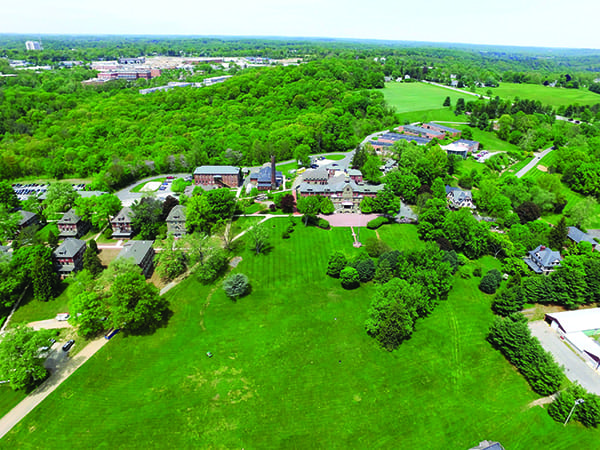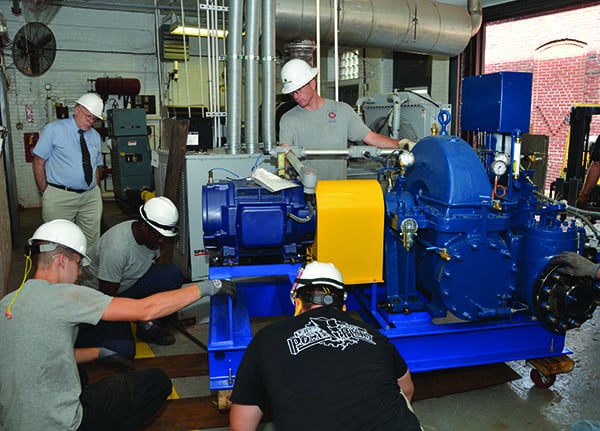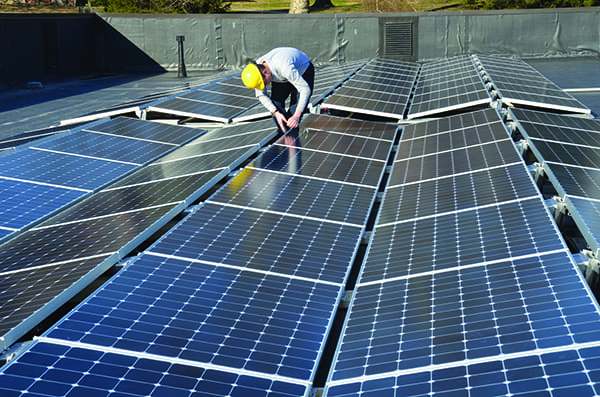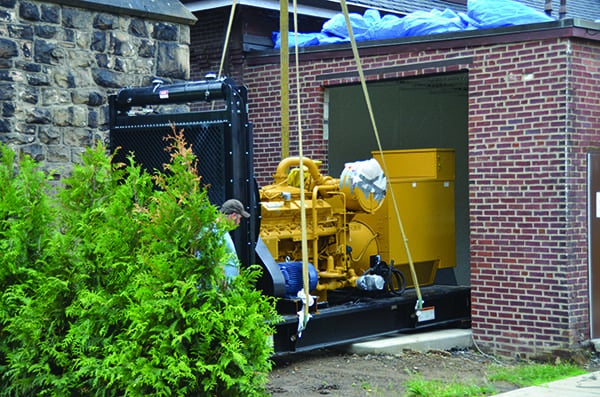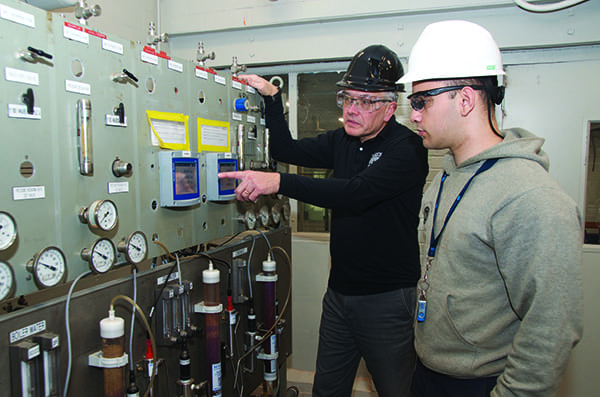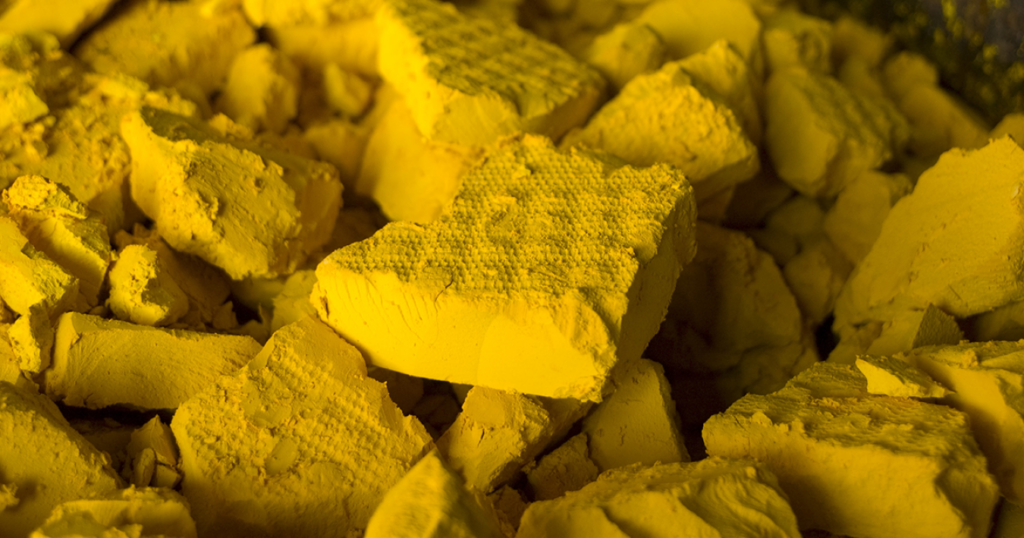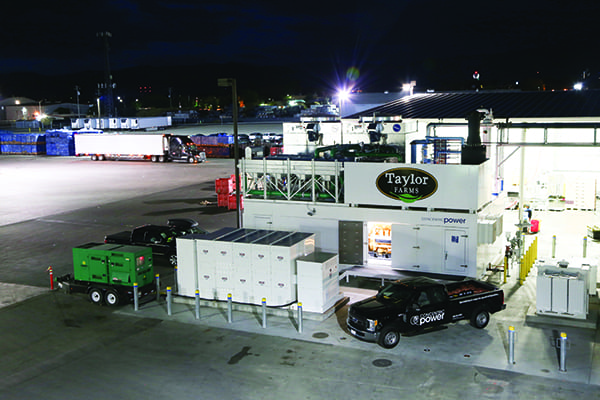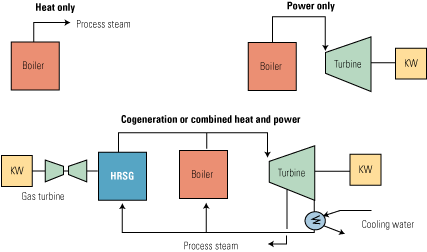Williamson College of the Trades’ Power Plant Technology program provides hands-on training for learners within its student-run power plant—known as the “Energy Island.” Through the program, students are exposed to innovative power technologies including a combined heat and power system, which generates electricity for the school’s grid and supplies a steam distribution network serving several campus buildings.
Cody B., junior class treasurer and power plant technology student, is grateful for the investment Williamson College of the Trades is making in him. Cody was eight years old when his father passed away. Throughout his life, Cody overcame many challenges and through it all, he maintained his drive to be successful. Regardless of the challenges around him, Cody knew he was different. He also knew that, in the right environment, he would certainly be successful and make his father proud.
For Cody and many young men like him, Williamson offers an extraordinary opportunity. Just 20 miles southwest of Philadelphia in Media, Pennsylvania, this fully residential men’s college offers a values-based curriculum. It employs an inclusive support system that provides 100% scholarships to all economically challenged students, and the school enables each to develop the character traits that position them for success in life.
The Lee Rowan School of Power Plant Technology
With one of just a handful of collegiate power plant technology programs in the U.S., Williamson provides an exceptional opportunity for hands-on training within its own power plant.
Students in the Lee Rowan School of Power Plant Technology gain valuable practical experience, preparing them for positions in the power and utilities industries through the operation of the college power plant and maintenance of its utilities. Graduates of the program are hired by utilities, industrial power facilities, refineries, manufacturers, and consulting firms as power plant operators, stationary engineers, field service technicians, instrumentation and controls technicians, and electrical/mechanical maintenance technicians.
Each semester, students spend on average 200 hours standing watch and performing shift work at the school’s power plant, which includes taking readings and making adjustments; starting up and shutting down boilers, turbines, and plant equipment; evaluating daily water treatment tests; analyzing flue gas emissions; and performing mechanical and electrical maintenance. Proper operation, maintenance, and testing of boilers, turbines, diesel engines, electric generators, switch gear, pumps, and other auxiliary equipment is a core component of the program curriculum.
Students learn nuclear, fossil fuel, hydroelectric, combined cycle, and other power generation system theory, as well as the basic principles of electricity, electrical power, motor controls, wiring diagrams, engineering mechanics, and mechanical and electrical systems.
This theoretical instruction is reinforced by hands-on training on-campus (Figure 1). The learning is supplemented through a shadowing program with local power plants during their first and second years, internships during summer breaks, and participation in a nuclear plant outage during their senior year.
When Williamson was founded in the late 19th century, campus power generation was a necessity, because the school was not located near a central power station and the grid did not exist. The college’s founder saw the instructional opportunity, envisioning a physical plant that could provide hands-on training in power generation. By default, Williamson became an Energy Island for the better part of a century—initiating its curriculum just a few years after Thomas Edison began developing central station power plants. Williamson was powered as an Energy Island by direct current power until the 1950s, followed by decades of electrical power generation training in a remarkable living classroom.
The Energy Island
Williamson trustees and alumni, working together with power industry professionals, have raised the funding and deliberately revitalized Williamson’s power plant to not only serve as its own Energy Island, but also to tie the system into the Williamson grid supplied by PECO Energy Co. power lines. Williamson is grateful to its trustees, alumni, and friends for their financial support, in-kind donations, and countless volunteer hours, which have been instrumental in improving facilities and enhancing curriculum focused on producing leaders for the industry year after year.
The current Energy Island project is only the second major upgrade of the physical plant since alternating current generators were installed in the late 1950s. When severe weather or auto accidents knock down power lines, Williamson now has the capability to separate from the grid and generate all of the power needed to operate the campus.
In addition to providing power and generating heat for the campus, today’s Energy Island in the Lee Rowan School of Power Plant Technology at Williamson College is the center for power plant training. The complex of buildings includes a shop maintenance building; the Rupp Power Plant, the school’s power/heat generating plant and living laboratory; and the Lipp Educational Center, which includes classrooms and faculty offices, a computer laboratory, a resource room with a technical library, and three separate laboratories for training in mechanical operations, industrial wiring, instrumentation, and electrical studies.
The Energy Island project was of such magnitude that it was executed in several phases, which included expansive modifications to the existing power plant, the addition of industry-relevant equipment, and major construction renovations. Besides incorporating more efficient technologies to provide power for campus facilities, the project has significantly improved the education provided to the college’s power plant technology students, preparing them more effectively for entry into the workforce.
Designed with Efficiency in Mind
Williamson has been previously featured in a POWER magazine article (see “World-Class Teaching Lab Prepares Next Generation of Plant Operators” in the June 2006 issue and online at powermag.com). Much has changed since that time. The following includes details about the current Energy Island arrangement and some improvements that have been implemented.
Steam Turbines and Combined Heat and Power. Williamson’s combined heat and power (CHP) system employs two Skinner steam turbines for electric power generation (Figure 2) with the high-pressure (HP) turbine driving a 75-kW induction generator. A portion of the HP turbine exhaust is used for steam distribution to several campus workshops and buildings, as well as the kitchen in the campus dining hall for meal preparation and cleanup.
The balance of the exhaust from the HP turbine flows to a 35-kW low-pressure (LP) Skinner condensing turbine. The LP exhaust steam (at about 170F) is cooled by the condenser circulating water and that exhaust heat energy is transferred to a thermal storage tank. During the winter, power is generated from the steam turbines and the exhaust heat is recovered to heat campus buildings and workshops. Two fire-tube boilers—capable of firing both natural gas and diesel oil—provide 125-psi steam.
Thermal Storage. A thermal storage system is designed to store exhaust steam heat in the form of water for campus heating.. This process utilizes the most effective and efficient CHP, 24 hours every day.
The concept of using stored water for chillers is common for stadiums and buildings that typically experience a surge in chilled water demand. Stored hot water for CHP, however, is not that common. The thermal storage system in Williamson’s microgrid provides the capability of generating power during peak daytime hours using the two-stage steam turbines and storing some of the exhaust heat overnight for building heating as electric demand decreases.
Solar Array. In an effort to incorporate renewable energy education into Williamson’s comprehensive program, a 92-kW solar array was installed on the roof of the campus sports center. The solar array demonstrates the practical application of solar panels to our students, as well as serving to reduce the electric peak power demand during the summer air conditioning season. The solar panels (Figure 3) have operated at a capacity factor of about 22% since startup in the summer of 2017, and they have achieved demand shaving and power savings to reduce peak load in the summer, keeping within a typical 200-kW to 350-kW average electrical load.
Natural Gas Reciprocating Engine. A Caterpillar G-3412, V-12, 450-kW reciprocating natural gas engine (Figure 4) was installed to use as a standby emergency generator (SEG). The Cat SEG is used to serve as a baseload generator and to stabilize campus power frequency and voltage when the campus operates in Energy Island mode, separate from PECO Energy.
Control Room and Distributed Control System (DCS). Located in the main power plant, the newly constructed control room mirrors that of a large central station power plant. A Rockwell Automation DCS system is under construction and will provide the students with the ability to monitor energy flows throughout the campus, including steam flows, boiler performance data, generated electricity from each unit, purchased power, electricity flows to each major building, and more. The control room functions to manage Energy Island processes while training students in energy balancing, energy flows, and economic dispatch of power.
Water and Fuels Laboratory. Because so much of today’s power generation involves chemistry, Williamson’s new Energy Island incorporates a state-of-the-art water and fuels laboratory to conduct liquid and solid fuel analyses. The laboratory is also used for instruction in water chemistry (Figure 5), and it serves as a quiet space within the power plant for small group lectures and instruction away from the sound of the steam turbines and gas engine.
Diesel Generators. Diesel fuel-powered generators have been installed at Williamson for many years. These are for training and emergency backup, which provide the school’s microgrid with off-grid power. Diesel generators typically run just a couple hundred hours per year.
Moving Forward
While the investment has been significant, the benefits of the Energy Island at Williamson are immeasurable. Improving safety, enriching curriculum, and upgrading facilities are substantial objectives that have been achieved for this societally relevant program. Yet, these are just a few of the anticipated outcomes. Incorporating Williamson’s approach of involving students in its operations, the Energy Island is designed to be operated by students, providing experiences for the next generation of power plant students that are unrivaled in any training program of its kind.
Williamson has been fortunate to have the support of countless alumni, corporations, foundations, and friends. All of the backers recognize the critical value that enhancing the school’s Energy Island provided. It allows instruction to reach the highest professional standards so that students receive the training needed to emerge as leaders within the power industry.
Cody has already completed a summer internship at a local refinery. By the time he graduates in 2019, he will likely be able to choose from numerous job offers for rewarding positions with major power and service companies across the country. With an overall job placement record of 98% (5-year average), the primary objective of a Williamson education is to enable every student to become highly proficient in his trade and secure employment in his field upon graduation. Williamson’s Energy Island has certainly created an opportunity for its power plant technology students to be successful in this remarkable industry. The school is extremely proud to have kept the Williamson power generation technology program current with the changing times. ■
—Michele Minicozzi is director of Grants & Research at Williamson College of the Trades. Richard F. (Dick) Storm, PE, contributed to this article. He is a 1962 graduate of Williamson and a current member of the Board of Trustees. Credit for images goes to Scott Chilman, director of the Power Generation Technology program, and Carl Vairo, director of Public Relations at Williamson.
Opening image courtesy: Williamson College of the Trades


